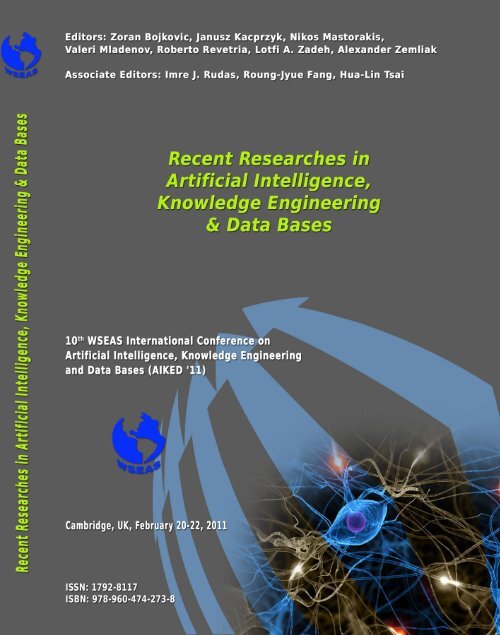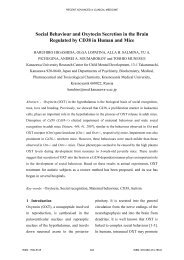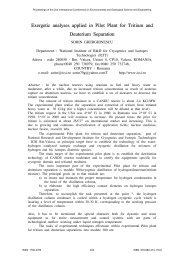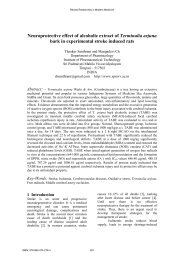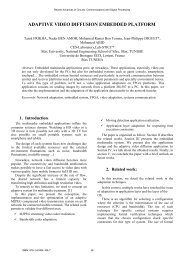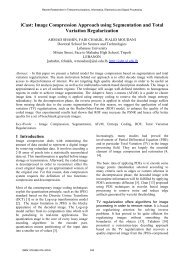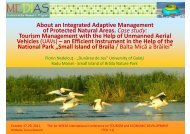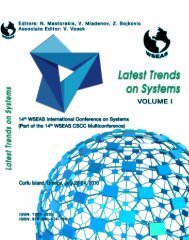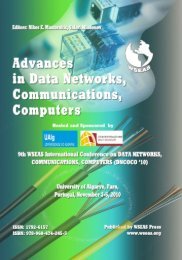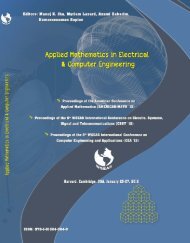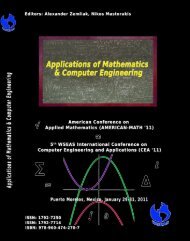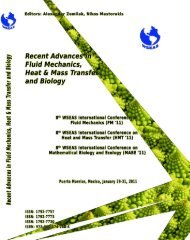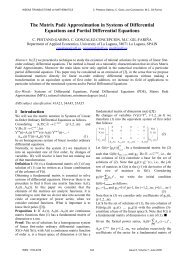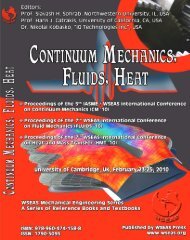Recent Researches in Artificial Intelligence, Knowledge ... - Wseas.us
Recent Researches in Artificial Intelligence, Knowledge ... - Wseas.us
Recent Researches in Artificial Intelligence, Knowledge ... - Wseas.us
Create successful ePaper yourself
Turn your PDF publications into a flip-book with our unique Google optimized e-Paper software.
RECENT RESEARCHES <strong>in</strong><br />
ARTIFICIAL INTELLIGENCE,<br />
KNOWLEDGE ENGINEERING and<br />
DATA BASES<br />
10th WSEAS International Conference on ARTIFICIAL<br />
INTELLIGENCE, KNOWLEDGE ENGINEERING and DATA<br />
BASES (AIKED '11)<br />
Cambridge, UK<br />
February 20-22, 2011<br />
Published by WSEAS Press<br />
www.wseas.org<br />
ISSN: 1792-8117<br />
ISBN: 978-960-474-273-8
RECENT RESEARCHES <strong>in</strong><br />
ARTIFICIAL INTELLIGENCE,<br />
KNOWLEDGE ENGINEERING and<br />
DATA BASES<br />
10th WSEAS International Conference on ARTIFICIAL<br />
INTELLIGENCE, KNOWLEDGE ENGINEERING and DATA<br />
BASES (AIKED '11)<br />
Cambridge, UK<br />
February 20-22, 2011<br />
Published by WSEAS Press<br />
www.wseas.org<br />
Copyright © 2011, by WSEAS Press<br />
All the copyright of the present book belongs to the World Scientific and Eng<strong>in</strong>eer<strong>in</strong>g Academy and<br />
Society Press. All rights reserved. No part of this publication may be reproduced, stored <strong>in</strong> a retrieval<br />
system, or transmitted <strong>in</strong> any form or by any means, electronic, mechanical, photocopy<strong>in</strong>g, record<strong>in</strong>g, or<br />
otherwise, without the prior written permission of the Editor of World Scientific and Eng<strong>in</strong>eer<strong>in</strong>g Academy<br />
and Society Press.<br />
All papers of the present volume were peer reviewed by two <strong>in</strong>dependent reviewers. Acceptance was<br />
granted when both reviewers' recommendations were positive.<br />
See also: http://www.worldses.org/review/<strong>in</strong>dex.html<br />
ISSN: 1792-8117<br />
ISBN: 978-960-474-273-8<br />
World Scientific and Eng<strong>in</strong>eer<strong>in</strong>g Academy and Society
RECENT RESEARCHES <strong>in</strong><br />
ARTIFICIAL INTELLIGENCE,<br />
KNOWLEDGE ENGINEERING and<br />
DATA BASES<br />
10th WSEAS International Conference on ARTIFICIAL<br />
INTELLIGENCE, KNOWLEDGE ENGINEERING and DATA<br />
BASES (AIKED '11)<br />
Cambridge, UK<br />
February 20-22, 2011
Editors:<br />
Prof. Zoran Bojkovic, University of Belgrade, SERBIA<br />
Prof. Jan<strong>us</strong>z Kacprzyk, International Fuzzy Systems Association, POLAND<br />
Prof. Nikos Mastorakis, Technical University of Sofia, BULGARIA<br />
Prof. Valeri Mladenov, Technical University of Sofia, BULGARIA<br />
Prof. Roberto Revetria, University of Genoa, ITALY<br />
Prof. Lotfi A. Zadeh, University of California, USA<br />
Prof. Alexander Zemliak, Autonomo<strong>us</strong> University of Puebla, MEXICO<br />
Associate Editors:<br />
Prof. Imre J. Rudas, Obuda University, HUNGARY<br />
Prof. Roung-Jyue Fang, Southern Taiwan University of Technology, TAIWAN<br />
Prof. Hua-L<strong>in</strong> Tsai, National Kaohsiung Normal University, TAIWAN<br />
International Program Committee Members:<br />
Lotfi A. Zadeh, USA<br />
Leonid Kazovsky, USA<br />
Charles Long, USA<br />
Roberto Revetria, USA<br />
M. Isabel Garcia-Planas, SPAIN<br />
Miguel Angel Gomez-Nieto, SPAIN<br />
Akshai Aggarwal, CANADA<br />
Pierre Borne, FRANCE<br />
Valeri Mladenov, BULGARIA<br />
Zoran S. Bojkovic, SERBIA<br />
G. Stavrakakis, GREECE<br />
Jan<strong>us</strong>z Kacprzyk, POLAND<br />
Angel Fernando Kuri Morales, MEXICO<br />
Arie Maharshak, ISRAEL<br />
Fumiaki Imado, JAPAN<br />
Toly Chen, TAIWAN<br />
Isak Taksa, USA<br />
G. R. Dattatreya, USA<br />
Shivanand Hiremath, INDIA
Preface<br />
This year the 10th WSEAS International Conference on ARTIFICIAL INTELLIGENCE,<br />
KNOWLEDGE ENGINEERING and DATA BASES (AIKED '11) was held <strong>in</strong> Cambridge, UK,<br />
February 20-22, 2011. The conference rema<strong>in</strong>s faithful to its orig<strong>in</strong>al idea of provid<strong>in</strong>g a<br />
platform to disc<strong>us</strong>s neural networks, mathematical foundation, time series analysis, fuzzy<br />
systems, <strong>in</strong>formation retrieval systems, image process<strong>in</strong>g, data security, b<strong>us</strong><strong>in</strong>ess architectures,<br />
video databases, content management, privacy issues, <strong>in</strong>teroperability issues, knowledge<br />
classification tools, digital watermark<strong>in</strong>g, electronic publish<strong>in</strong>g, artistic imag<strong>in</strong>g, digital<br />
typography, geographic <strong>in</strong>formation systems, wireless networks etc. with participants from all<br />
over the world, both from academia and from <strong>in</strong>d<strong>us</strong>try.<br />
Its success is reflected <strong>in</strong> the papers received, with participants com<strong>in</strong>g from several countries,<br />
allow<strong>in</strong>g a real mult<strong>in</strong>ational multicultural exchange of experiences and ideas.<br />
The accepted papers of this conference are published <strong>in</strong> this Book that will be <strong>in</strong>dexed by ISI.<br />
Please, check it: www.worldses.org/<strong>in</strong>dexes as well as <strong>in</strong> the CD-ROM Proceed<strong>in</strong>gs. They will<br />
be also available <strong>in</strong> the E-Library of the WSEAS. The best papers will be also promoted <strong>in</strong> many<br />
Journals for further evaluation.<br />
A Conference such as this can only succeed as a team effort, so the Editors want to thank the<br />
International Scientific Committee and the Reviewers for their excellent work <strong>in</strong> review<strong>in</strong>g the<br />
papers as well as their <strong>in</strong>valuable <strong>in</strong>put and advice.<br />
The Editors
<strong>Recent</strong> <strong>Researches</strong> <strong>in</strong> <strong>Artificial</strong> <strong>Intelligence</strong>, <strong>Knowledge</strong> Eng<strong>in</strong>eer<strong>in</strong>g and Data Bases<br />
Table of Contents<br />
Plenary Lecture 1: Aggregation <strong>in</strong> Intelligent Systems 14<br />
Imre J. Rudas<br />
Plenary Lecture 2: Cosmology, Holography, the Bra<strong>in</strong> and the Quantum Vacuum 15<br />
Antonio Alfonso-Fa<strong>us</strong><br />
Plenary Lecture 3: Content Delivery Networks: Evolution, Technology, Functions, Potential<br />
Solutions, Research Areas<br />
Zoran Bojkovic<br />
Plenary Lecture 4: Case-Based Reason<strong>in</strong>g Framework for Medical Diagnosis for Virtual<br />
Doctor System<br />
Hamido Fujita<br />
16<br />
17<br />
Thoughts and Th<strong>in</strong>k<strong>in</strong>g 19<br />
Roger Ellman<br />
A Genetic Algorithm for the Job Shop Schedul<strong>in</strong>g with a New Local Search <strong>us</strong><strong>in</strong>g Monte Carlo<br />
Method<br />
Jorge Magalhaes-Mendes<br />
26<br />
Us<strong>in</strong>g Some Data M<strong>in</strong><strong>in</strong>g Techniques for Early Diagnosis of Lung Cancer 32<br />
Zakaria Suliman Zubi, Rema Asheibani Saad<br />
A Development of Portable Three Dimensional Position Data Measurement Device for<br />
Character or Object Model<strong>in</strong>g <strong>in</strong> Computer Animation<br />
Suriyong Lertkulvanich, Nithi Buranajant, Suwanna Sombunsukho<br />
The Development of the Equipment Reservation System for Computer and Information<br />
Technology Department<br />
Chan<strong>in</strong> Tungpantong, Kullanit Laohaphiboonrattana, Chananda P<strong>in</strong>ta, Teeraporn Wattanasopa,<br />
Napapol Sonjai<br />
38<br />
41<br />
The Development Information System for Digital Media Service 45<br />
Kasemsak Sritaratorn, Inthira Paleenud, Suwanna Sombunsukho, Nithi Buranajant<br />
The Development Information System Student Care Center Project The case of Computer and<br />
Information Technology Department<br />
Suwanna Sombunsukho, Oraya Petchurai<br />
49<br />
The Development Information System for Adm<strong>in</strong>istrative 52<br />
Suwanna Sombunsukho, K<strong>in</strong>gkaew Phontrakoon<br />
The Development Computer Assisted Instruction on Introduction to Programm<strong>in</strong>g Subject 55<br />
Suwanna Sombunsukho, Warong Thavara, Prapatsorn An<strong>in</strong>bon<br />
A Study on the Innovative Design Processes by Us<strong>in</strong>g Su-Field Model<strong>in</strong>g Method Integrated<br />
with Extension of Matter-Element<br />
Chang-Tzuoh Wu, Hung-Jen Yang, Hsueh-Chih L<strong>in</strong>, Shang M<strong>in</strong>g Su<br />
59<br />
ISBN: 978-960-474-273-8 9
<strong>Recent</strong> <strong>Researches</strong> <strong>in</strong> <strong>Artificial</strong> <strong>Intelligence</strong>, <strong>Knowledge</strong> Eng<strong>in</strong>eer<strong>in</strong>g and Data Bases<br />
A Study on the Geometry Model for Accuracy Evaluation <strong>in</strong> Numerically Controlled Mill<strong>in</strong>g<br />
Mach<strong>in</strong>es<br />
Chang-Tzuoh Wu, Hung-Jen Yang, Hsueh-Chih L<strong>in</strong>, Shang M<strong>in</strong>g Su<br />
66<br />
M<strong>in</strong><strong>in</strong>g of Frequent Itemsets with Jo<strong>in</strong>FI-M<strong>in</strong>e Algorithm 73<br />
Supatra Sahaphong, Gumpon Sritanratana<br />
A Convergence Theorem for Jungck-Ishikawa Iteration 79<br />
Bhagwati Prasad, Ritu Sahni<br />
A Particular Proposal Towards the Internal Architecture of the Inferential Motor Learn<strong>in</strong>g<br />
Process and its Entropy Congruence with the Procedural Refactor<strong>in</strong>g of Computerization<br />
Field<br />
Nicolae Neagu, Dana Badau, Crist<strong>in</strong>a Branea, Virgil Tudor, Elena Sabau, Gabriel Mar<strong>in</strong><br />
Manolache<br />
A Study of Effect Affect<strong>in</strong>g to Energy <strong>in</strong> Dry<strong>in</strong>g ProcessbyFailure Modes and Effect Analysis<br />
(FMEA)<br />
Vanchai Laemlaksakul<br />
Neural Cognitions of Perceiv<strong>in</strong>g Ch<strong>in</strong>ese Characters: Phonological vers<strong>us</strong> Logographical<br />
Effects<br />
Shu-Yu Lyu, Wun-Tsong Chaou, Hao-Yu Yang<br />
Stat<strong>us</strong>, Needs and Problems for Us<strong>in</strong>g Onl<strong>in</strong>e Course of Ind<strong>us</strong>trial Technology Filed at<br />
Rajamangala University of Technology Isan<br />
Supreeya Siripattanakunkajorn, Khomsan Reetanon, Santirat Nansaarng<br />
85<br />
91<br />
95<br />
98<br />
Optimal Operation of Chiller System Us<strong>in</strong>g Fuzzy Control 109<br />
Zazilah May, Nursyarizal Mohd Nor, Kamaruzaman J<strong>us</strong>off<br />
The Obstructed & Required Competence of Skills Development tra<strong>in</strong>ers Department of Skill<br />
Development, Thailand<br />
Montree Prajugjit, Sittichai Kaewkuekool<br />
116<br />
Risk Perception of the E-Payment Systems: A Young Adult Perspective 121<br />
Aw Yoke Cheng, Noor Raihan Ab Hamid, Eaw Hooi Cheng<br />
Contribution to Content Delivery Network Analysis 128<br />
Zoran Bojkovic, Zoran Milicevic<br />
Risk Management of Internet Bank<strong>in</strong>g 134<br />
Shapoor Zarei<br />
Cl<strong>us</strong>ter<strong>in</strong>g with Complex Centers 140<br />
Issam Dagher<br />
Extraction of Interpretable Rules from Piecewise-L<strong>in</strong>ear Approximation of a Nonl<strong>in</strong>ear<br />
Classifier Us<strong>in</strong>g Cl<strong>us</strong>ter<strong>in</strong>g-Based Decomposition<br />
Andrey Bondarenko, Vilen Jumutc<br />
145<br />
The Advantage of the New Technologies <strong>in</strong> Learn<strong>in</strong>g 150<br />
Flor<strong>in</strong> Radu, Valent<strong>in</strong> Radu, Gabriel Croitoru<br />
ISBN: 978-960-474-273-8 10
<strong>Recent</strong> <strong>Researches</strong> <strong>in</strong> <strong>Artificial</strong> <strong>Intelligence</strong>, <strong>Knowledge</strong> Eng<strong>in</strong>eer<strong>in</strong>g and Data Bases<br />
Lattices and Patterns 156<br />
Sylvia Encheva<br />
Dom<strong>in</strong>ance Relations <strong>in</strong> Rough Sets Approximations for Assess<strong>in</strong>g Students <strong>Knowledge</strong> 162<br />
Sylvia Encheva<br />
Galois Sub-Hierarchy and Order<strong>in</strong>gs 168<br />
Sylvia Encheva<br />
Interval Data and Nested Lattices 172<br />
Sylvia Encheva<br />
Some Fuzzy Logic based Predictions 176<br />
Sylvia Encheva<br />
Technology Development Model <strong>us</strong>ed for a Small Company <strong>in</strong> Romania (Creation and Use of<br />
an On L<strong>in</strong>e Shop)<br />
Rozalia Nistor, Costel Nistor, Mihaela-Carmen Muntean<br />
Modern Computer Systems, Support of Seek<strong>in</strong>g Competitive Advantage <strong>in</strong> the Romanian<br />
Railway Transportation<br />
Costel Nistor, Rozalia Nistor, Mihaela-Carmen Muntean<br />
181<br />
187<br />
A Learn<strong>in</strong>g System of Digital Design<strong>in</strong>g and Manufactur<strong>in</strong>g for Creative Products 193<br />
Wei-Yuan Dzan, Hsueh-Chih L<strong>in</strong>, Lung- Hs<strong>in</strong>g Kuo , Shang M<strong>in</strong>g Su, Chang-Tzuoh Wu, Hung-Jen<br />
Yang<br />
Adaptive Neuro-Fuzzy Model<strong>in</strong>g for Crop Yield Prediction 199<br />
Kefaya Qaddoum, Evor H<strong>in</strong>es, Daciana Illiescu<br />
Inform<strong>in</strong>g and Socializ<strong>in</strong>g <strong>in</strong> Interactive Spaces: Deliver<strong>in</strong>g the Right Information to the Right<br />
Users<br />
Fernando Ribeiro, Monica Costa, Jose Metrolho<br />
205<br />
Ways to Increase the Efficiency of Information Systems 211<br />
Manole Velicanu, Iulia Surugiu, Daniela Litan, Ovidiu Raduta, Larisa Copcea Teohari, Mihai<br />
Teohari, Aura-Mihaela Mocanu Virgolici<br />
Server Farms’ Power Consumption M<strong>in</strong>imized Via Best Allocation of Servers and Ancillary<br />
Equipments<br />
Sondos A. Moreb, Stuart O. Walker<br />
217<br />
Implementation of Spatio-Temporal Data Types with Java Generics 228<br />
Kresimir Krizanovic, Zdravko Galic, Mirta Baranovic<br />
Improv<strong>in</strong>g the Performance of M<strong>in</strong>or Class <strong>in</strong> Decision Tree Us<strong>in</strong>g Duplicat<strong>in</strong>g Instances 234<br />
Hyontai Sug<br />
An Efficient Discovery of Class-Restricted MARs 238<br />
Hyontai Sug<br />
Seek<strong>in</strong>g for Fundamental Factors beh<strong>in</strong>d the Co-Movement of Foreign Exchange Time Series,<br />
<strong>us</strong><strong>in</strong>g Bl<strong>in</strong>d Source Separation Techniques<br />
Vasile Georgescu, Alice Dal<strong>in</strong>a Matei<br />
243<br />
ISBN: 978-960-474-273-8 11
<strong>Recent</strong> <strong>Researches</strong> <strong>in</strong> <strong>Artificial</strong> <strong>Intelligence</strong>, <strong>Knowledge</strong> Eng<strong>in</strong>eer<strong>in</strong>g and Data Bases<br />
Cosmology, Holography, the Bra<strong>in</strong> and the Quantum Vacuum 249<br />
Antonio Alfonso-Fa<strong>us</strong><br />
An Overview of Migrative Triangular Norms 255<br />
Imre J. Rudas, Janos Fodor<br />
On Possibilistic Correlation Coefficient and Ratio for Fuzzy Numbers 263<br />
Robert Fuller, Istvana Harmati, Jozsef Mezei, Peter Varlaki<br />
The AHP Extended Fuzzy Based Risk Management 269<br />
Marta Takacs, Tothne Laufer Edit<br />
An Introduction <strong>in</strong> the Design of Decision Support Systems Mixed with Soft Comput<strong>in</strong>g, for<br />
Extreme Risk Management (DSS-ERM)<br />
Prelipcean Gabriela, Boscoianu Mircea<br />
273<br />
A Simple Algorithm for Pitch Distance Determ<strong>in</strong>ation 279<br />
Gyula Hermann<br />
Information Technology In Support<strong>in</strong>g <strong>Knowledge</strong> Management 283<br />
Vasile Horga, Mihaela Horga, Maria Gabriela Horga<br />
F<strong>in</strong>ancial Control In Prevent<strong>in</strong>g And Combat<strong>in</strong>g Money Launder<strong>in</strong>g 288<br />
Vasile Horga<br />
Bioclimate Weather Classification of Doboj for Helth Spa Tourism 292<br />
Milovan Pecelj, Milica Pecelj, Milisav Cutovic, Mila Pavlovic, Dragica Zivkovic, Ljiljana Zivkovic,<br />
Snezana Vujad<strong>in</strong>ovic, Jelena Pecelj, Mirjana Gajic, Danimir Mandic<br />
HOSVD Based Image Process<strong>in</strong>g Techniques 297<br />
Andras Rovid, Imre J. Rudas, Szabolcs Sergyan, Laszlo Szeidl<br />
Apply<strong>in</strong>g Big 6 on Digital Book for Support<strong>in</strong>g Learn<strong>in</strong>g 303<br />
Lung-Hs<strong>in</strong>g Kuo, Shao-Chun Yang, Wen-Chen Hu, Chang-Tzuoh Wu, Hung-Jen Yang, Hsueh-Chih<br />
L<strong>in</strong><br />
Decision Support System <strong>in</strong> Physical Education 309<br />
Danimir Mandic, Dragan Mart<strong>in</strong>ovic, Nenad Lalic, Veljko Bandjur<br />
Towards Human Controlled Intelligent Product Eng<strong>in</strong>eer<strong>in</strong>g Systems 314<br />
Laszlo Horvath, Imre J. Rudas<br />
Towards a Hierarchical Temporal Memory Based Self-managed Dynamic Tr<strong>us</strong>t Replication<br />
Mechanism <strong>in</strong> Cognitive Mobile Ad-Hoc Networks<br />
Ricardo J. Rodriguez, James A. Cannady<br />
The Role of Contemporary Information and Communication Technologies <strong>in</strong> Market<strong>in</strong>g<br />
Decision <strong>in</strong> the Enterprise<br />
Radovan Tomic, Dragica Tomic, Maja Durica, Gordana Tomic<br />
320<br />
329<br />
Algorithm and Program for the Temperature Analysis <strong>in</strong> a Fire Compartment 334<br />
D. P<strong>in</strong>tea, R. Zaharia<br />
Semantical Case Based Reason<strong>in</strong>g related to Virtual Doctor System (VDS) 340<br />
Hamido Fujita, Jun Hakura, Masaki Kurematsu<br />
ISBN: 978-960-474-273-8 12
<strong>Recent</strong> <strong>Researches</strong> <strong>in</strong> <strong>Artificial</strong> <strong>Intelligence</strong>, <strong>Knowledge</strong> Eng<strong>in</strong>eer<strong>in</strong>g and Data Bases<br />
Cloud based Unsupervised Learn<strong>in</strong>g Architecture based on Mirror<strong>in</strong>g Neural Networks 350<br />
K. Eswaran, C.Chaitanya<br />
In the <strong>Artificial</strong> Society of Choos<strong>in</strong>g Digitalized Teach<strong>in</strong>g Materials with Theory of Planned<br />
Behavior<br />
Rong-Jyue Fang, Hua- L<strong>in</strong> Tsai, Chi -Jen Lee, Ch<strong>in</strong> An- L<strong>in</strong><br />
354<br />
In the <strong>Artificial</strong> Society of E-Learn<strong>in</strong>g Enhances the Learn<strong>in</strong>g Effect 359<br />
Rong-Jyue Fang, Hua- L<strong>in</strong> Tsai, Chi -Jen Lee, Chien Cheng-Wu<br />
In the <strong>Artificial</strong> Society of Whiteboard to Improve Teach<strong>in</strong>g 366<br />
Rong-Jyue Fang, Hua- L<strong>in</strong> Tsai, Chi -Jen Lee, Cheng-En Hung<br />
In the <strong>Artificial</strong> Society of Elementary Schools have a Trouble <strong>in</strong> Life Course Teach<strong>in</strong>g 374<br />
Rong-Jyue Fang, Wen-Jiuh Chiang, Hua- L<strong>in</strong> Tsai, Wan Ch<strong>in</strong>g Wu<br />
A Study of The <strong>Artificial</strong> Society for Teach<strong>in</strong>g Multimedia Network 382<br />
Rong-Jyue Fang, Wen-Jiuh Chiang, Hua- L<strong>in</strong> Tsai, Yung-Sheng Chang<br />
In the <strong>Artificial</strong> Society of Impet<strong>us</strong> Electronic Textbook <strong>in</strong> Widespread Use 389<br />
Rong-Jyue Fang, Yi-Hs<strong>in</strong>g Chang, Hua- L<strong>in</strong> Tsai, Tien-Sheng Tsai<br />
A Descriptive Model for Predict<strong>in</strong>g Popular Areas <strong>in</strong> a Web Map 397<br />
Ricardo Garcia, Juan Pablo De Castro, Maria Jes<strong>us</strong> Verdu, Elena Verdu, Luisa Maria Regueras,<br />
Pablo Lopez<br />
A Computational Framework for Academic Accreditation and Assessment <strong>in</strong> Higher<br />
Education (A3-HE) – Part 1 Academic Processes<br />
Aboubekeur Hamdi-Cherif<br />
A Computational Framework for Academic Accreditation and Assessment <strong>in</strong> Higher<br />
Education (A3-HE) – Part 2 Technologies<br />
Aboubekeur Hamdi-Cherif<br />
403<br />
411<br />
Normalization of Relations and Ontologies 419<br />
Lule Ahmedi, Edmond Jajaga<br />
An Analysis of the Performances of Intelligent Hybrid Decision Support Systems with<br />
Applications <strong>in</strong> Crisis Management<br />
Prelipcean Gabriela, Boscoianu Mircea<br />
425<br />
Authors Index 431<br />
ISBN: 978-960-474-273-8 13
<strong>Recent</strong> <strong>Researches</strong> <strong>in</strong> <strong>Artificial</strong> <strong>Intelligence</strong>, <strong>Knowledge</strong> Eng<strong>in</strong>eer<strong>in</strong>g and Data Bases<br />
Plenary Lecture 1<br />
Aggregation <strong>in</strong> Intelligent Systems<br />
Professor Imre J. Rudas<br />
Rector<br />
Obuda University, Hungary<br />
E-mail: rudas@uni-obuda.hu<br />
Abstract: The problem of aggregat<strong>in</strong>g <strong>in</strong>formation represented by fuzzy sets <strong>in</strong> a mean<strong>in</strong>gful way has been of central<br />
<strong>in</strong>terest s<strong>in</strong>ce the late 1970s. In most cases, the aggregation operators are def<strong>in</strong>ed on a pure axiomatic basis and are<br />
<strong>in</strong>terpreted either as logical connectives (such as t-norms and t-conorms) or as averag<strong>in</strong>g operators allow<strong>in</strong>g a<br />
compensation effect (such as the arithmetic mean).<br />
On the other hand, it can be observed by some empirical tests that the above-mentioned classes of operators differ<br />
from those ones that people <strong>us</strong>e <strong>in</strong> practice. Therefore, it is important to f<strong>in</strong>d operators that are, <strong>in</strong> a sense, mixtures<br />
of the previo<strong>us</strong> ones, and allow some degree of compensation.<br />
This talk summarizes the research results of the author and his co-workers that have been carried out <strong>in</strong> recent years<br />
on generalization of conventional aggregation operators. This <strong>in</strong>cludes, but is not limited to, the class of un<strong>in</strong>orms and<br />
nullnorms, absorb<strong>in</strong>g norms, distance- and entropy-based operators, quasi-conjunctions and nonstrict means.<br />
Brief Biography of the Speaker: Imre J. Rudas graduated from Banki Donat Polytechnic, Budapest <strong>in</strong> 1971,<br />
received the Master Degree <strong>in</strong> Mathematics from the Eotvos Lorand University, Budapest, the Ph.D. <strong>in</strong> Robotics from<br />
the Hungarian Academy of Sciences <strong>in</strong> 1987, while the Doctor of Science degree from the Hungarian Academy of<br />
Sciences <strong>in</strong> 2004. He received his first Doctor Honoris Ca<strong>us</strong>a degree from the Technical University of Kosice,<br />
Slovakia and the second one from “Polytechnica” University of Timisoara, Romania.<br />
He is active as a full university professor. He served as the Rector of Budapest Tech from Aug<strong>us</strong>t 1, 2003 for a period<br />
of four years, and was reelected for three years <strong>in</strong> 2007. From 2010 Budapest Tech is changed to Obuda University<br />
and he was elected as the rector for five years.<br />
He is a Fellow of IEEE, Senior Adm<strong>in</strong>istrative Committee member of IEEE Ind<strong>us</strong>trial Electronics Society, member of<br />
Board of Governors of IEEE SMC Society, Chair of IEEE Hungary Section and Vice-President of the Hungarian<br />
Academy of Eng<strong>in</strong>eer<strong>in</strong>g.<br />
He is the treasurer of IFSA (International Fuzzy System Association), he had been the President of Hungarian Fuzzy<br />
Association for ten years.<br />
He serves as an associate editor of some scientific journals, <strong>in</strong>clud<strong>in</strong>g IEEE Transactions on Ind<strong>us</strong>trial Electronics,<br />
member of editorial board of Journal of Advanced Computational <strong>Intelligence</strong>, member of vario<strong>us</strong> national and<br />
<strong>in</strong>ternational scientific committees. He is the founder of the IEEE International Conference Series on Intelligent<br />
Eng<strong>in</strong>eer<strong>in</strong>g Systems (INES) and IEEE International Conference on Computational Cybernetics (ICCC), and some<br />
<strong>in</strong>ternational symposia. He has served as General Chairman and Program Chairman of numero<strong>us</strong> scientific<br />
<strong>in</strong>ternational conferences.<br />
His present areas of research activity are Computational Cybernetics, Robotics with special emphasis on Robot<br />
Control, Soft Comput<strong>in</strong>g, Computed-aided Process Plann<strong>in</strong>g, Fuzzy Control and Fuzzy Sets. He has published<br />
books, more than 450 papers <strong>in</strong> books, vario<strong>us</strong> scientific journals and <strong>in</strong>ternational conference proceed<strong>in</strong>gs. He<br />
received more than 600 citations for his publications.<br />
ISBN: 978-960-474-273-8 14
<strong>Recent</strong> <strong>Researches</strong> <strong>in</strong> <strong>Artificial</strong> <strong>Intelligence</strong>, <strong>Knowledge</strong> Eng<strong>in</strong>eer<strong>in</strong>g and Data Bases<br />
Plenary Lecture 2<br />
Cosmology, Holography, the Bra<strong>in</strong> and the Quantum Vacuum<br />
Professor Antonio Alfonso-Fa<strong>us</strong><br />
"Ad Honorem" Madrid Technical University (UPM)<br />
SPAIN<br />
E-mail: aalfonsofa<strong>us</strong>@yahoo.es<br />
Abstract: Cosmology, as a science, started at the beg<strong>in</strong>n<strong>in</strong>g of the last century with the advent of the E<strong>in</strong>ste<strong>in</strong><br />
cosmological equations. Based on these equations, the present ma<strong>in</strong> stream cosmological model is the well known<br />
big-bang (this name unwill<strong>in</strong>gly co<strong>in</strong>ed by Fred Hoyle many years ago). Relatively recent additions to this model have<br />
been <strong>in</strong>flation, dark matter and dark energy.<br />
This talk presents a smoothly behaved new cosmological model that ma<strong>in</strong>ly takes <strong>in</strong>to account the "dark" part of the<br />
Universe. We consider it as the background frame, the substrate, of what we see. The <strong>in</strong>cl<strong>us</strong>ion of the holographic<br />
pr<strong>in</strong>ciple clarifies the entropy problem that we also apply to the human bra<strong>in</strong>. We take it as an eng<strong>in</strong>eer<strong>in</strong>g <strong>in</strong>formation<br />
center. F<strong>in</strong>ally, the <strong>in</strong>cl<strong>us</strong>ion of the quantum vacuum <strong>in</strong> this scene creates an important challenge, an opportunity for<br />
future research <strong>in</strong> the knowledge of the Universe.<br />
Brief Biography of the Speaker: Antonio Alfonso-Fa<strong>us</strong> graduated from the Technical University of Madrid (UPM),<br />
Spa<strong>in</strong>, <strong>in</strong> 1964. He received the Diploma Space Science (Physics and Dynamics) from the University College,<br />
London, U.K., <strong>in</strong> 1965. Then he received the Master of Science Degree <strong>in</strong> Physics and Mathematics from the<br />
University of M<strong>in</strong>nesota, U.S.A., <strong>in</strong> 1967, followed by the Ph.D. Degree (Physics and Mathematics) at the same<br />
University, <strong>in</strong> 1968. He also holds a Doctor of Aeronautical Eng<strong>in</strong>eer<strong>in</strong>g Degree from the Technical University of<br />
Madrid (UPM), Spa<strong>in</strong>, <strong>in</strong> 1969. Presently he is active as an Ad Honorem Professor (2010), at the same UPM, where<br />
he has served teach<strong>in</strong>g and research<strong>in</strong>g for the last 35 years. He served as academic positions: member of the board<br />
(6 years), coord<strong>in</strong>ator of the Mechanical Eng<strong>in</strong>eer<strong>in</strong>g Unite (10 years) and Director of the "Aerotecnia" Department (6<br />
years) at the E.U.I.T. Aeronautica, UPM.<br />
He was a collaborator (5 years, 1968-1973) for the National Technical Institute for Aerospace (INTA, Spa<strong>in</strong>), worked<br />
for Iberia L.A.E. (22 Years, 1973-1995) bridg<strong>in</strong>g knowledge between the University and the Ind<strong>us</strong>try. Member of the<br />
S.A.E. (U.S.A.) for aircraft eng<strong>in</strong>es technical specification for the Ind<strong>us</strong>try, Chairman of the Eng<strong>in</strong>e Trend Monitor<strong>in</strong>g<br />
Team (ATLAS, four years), referee for vario<strong>us</strong> <strong>in</strong>ternational scientific journals, chairman of vario<strong>us</strong> scientific<br />
<strong>in</strong>ternational conferences (Frontiers of Fundamental Physics, Science for Health), full professor of Mechanical<br />
Eng<strong>in</strong>eer<strong>in</strong>g at the UPM (1995-2009), Golden Medal Award (UPM, 1999).<br />
Research activities: Solar W<strong>in</strong>d, Interplanetary Magnetic Field, Lunar Wake, Cosmology and Astrophysics.<br />
ISBN: 978-960-474-273-8 15
<strong>Recent</strong> <strong>Researches</strong> <strong>in</strong> <strong>Artificial</strong> <strong>Intelligence</strong>, <strong>Knowledge</strong> Eng<strong>in</strong>eer<strong>in</strong>g and Data Bases<br />
Plenary Lecture 3<br />
Content Delivery Networks: Evolution, Technology, Functions, Potential Solutions,<br />
Research Areas<br />
Professor Zoran Bojkovic<br />
Full Prof. of Electrical Eng<strong>in</strong>eer<strong>in</strong>g<br />
University of Belgrade, Serbia<br />
E-mail: z.bojkovic@yahoo.com<br />
Abstract: Content delivery network (CDN) is a comprehensive, end- to-end solution for optimiz<strong>in</strong>g global networks for<br />
Web content delivery. Users request<strong>in</strong>g <strong>in</strong>formation from a Web site may have those requests served from a location<br />
closer to them than the orig<strong>in</strong>al server on which it is generated. By serv<strong>in</strong>g content from po<strong>in</strong>ts a lot closer to the <strong>us</strong>er,<br />
a CDN reduces the likelihood of hot spots by dispers<strong>in</strong>g the different po<strong>in</strong>ts of convergence and by distribut<strong>in</strong>g the<br />
workload among multiple servers. Deliver<strong>in</strong>g content from the edge of the network <strong>in</strong>stead of the orig<strong>in</strong>al server has<br />
the added benefit of additional reliability. The probability of the lost packets is decreased, while the performance of<br />
stream<strong>in</strong>g audio and video is improved.<br />
CDNs deploy servers <strong>in</strong> multiple geographically diverse locations <strong>in</strong> order to redirect <strong>us</strong>ers requests to the nearest<br />
available servers. End <strong>us</strong>ers observe higher QoS, while content providers offer more reliable and larger volumes of<br />
the service. At the same time, Internet service providers (ISPs) can also benefit from deploy<strong>in</strong>g CDN servers <strong>in</strong> their<br />
networks, as the total amount of the traffic transmitted <strong>in</strong> the backbone is reduced. In order to address the issue faced<br />
by many content providers, companies started to provide a service called content distribution network service.<br />
Content distribution network is a "shared" <strong>in</strong>frastructure <strong>in</strong> that the mirror servers (also called replica servers)<br />
belong<strong>in</strong>g to a network service provider are <strong>us</strong>ually "shared" between multiple content providers. The value provided<br />
by the network service providers is measured by the amount of content downloaded from the major servers and the<br />
peak bandwidth needed to serve the content from the mirror servers. One of the ma<strong>in</strong> challenges for providers is to<br />
be able to f<strong>in</strong>d the "nearest" mirror server correspond<strong>in</strong>g to a client. Typically, the IP address of the client is <strong>us</strong>ed to<br />
identify the location of the client.<br />
This plenary speech is organized as follows. After the <strong>in</strong>troduction, show<strong>in</strong>g the current stat<strong>us</strong> <strong>in</strong> the area, the next<br />
section will describe the evolution of content delivery technologies, together with content delivery network functions.<br />
The fact that the content delivery technique offers the service of large scale based on IP networks is taken <strong>in</strong>to<br />
account. In order to satisfy QoS requirements for heterogeneo<strong>us</strong> Internet applications, system performances are<br />
improved. The second part deals with potential solutions to problems <strong>in</strong> IP networks. The emerg<strong>in</strong>g applications<br />
require vary<strong>in</strong>g amounts of reliability, functionality, speed, efficiency, cost, effectiveness and scalability. Therefore, it<br />
is necessary to bridge the gap between the emerg<strong>in</strong>g heterogeneo<strong>us</strong> applications with vario<strong>us</strong> demands of service<br />
capacity and IP networks. The emerg<strong>in</strong>g challenges are server placement and organization, content distribution,<br />
request rout<strong>in</strong>g and system management. Several approaches are opened for consideration like: efficient stream<strong>in</strong>g<br />
<strong>in</strong> future Internet, end-to-end multimedia communications across complex comb<strong>in</strong>ations of networks, peer-to-peer<br />
hybrid or fully distributed network<strong>in</strong>g for content handl<strong>in</strong>g, content adaptation to facilitate content capabilities, etc.<br />
Brief Biography of the Speaker: Prof. dr Zoran Bojkovic is full professor of Electrical Eng<strong>in</strong>eer<strong>in</strong>g, University of<br />
Belgrade, Serbia. Also, he is a permanent visit<strong>in</strong>g professor at the University of Texas at Arl<strong>in</strong>gton, TX, USA, EE<br />
Department. Until now, he has taught a number of courses <strong>in</strong> Electrical Technology, Telecommunication Systems,<br />
Image and Video Process<strong>in</strong>g, Multimedia Wire/Wireless Communication Systems. He is the author or co-author of 6<br />
<strong>in</strong>ternational books published <strong>in</strong> USA, Canada, S<strong>in</strong>gapore, Ch<strong>in</strong>a, India, Greece and Romania. Also, he has<br />
published 2 national monographies, 13 textbooks as well as more than 400 papers <strong>in</strong> peer-reviewed journals and<br />
conference proceed<strong>in</strong>gs. He has been Editor-<strong>in</strong>-Chief <strong>in</strong> 2 and Associate Editor <strong>in</strong> 3 WSEAS Journals. At present, he<br />
is a member of Editorial Board <strong>in</strong> 6 International Journals. He is co-editor <strong>in</strong> 51 International Books and International<br />
Conference Proceed<strong>in</strong>gs. He has conducted workshops/tutorials and sem<strong>in</strong>ars worldwide and participated <strong>in</strong> more<br />
than 70 research and <strong>in</strong>d<strong>us</strong>trial projects all over the world. Also, he has been a consultant to <strong>in</strong>d<strong>us</strong>try, research<br />
<strong>in</strong>stitutes and academia. Prof. Bojkovic is an active researcher <strong>in</strong> wire/wireless multimedia communications. He is a<br />
Senior Member of IEEE and WSEAS member of EURASIP. He is a full member of Eng<strong>in</strong>eer<strong>in</strong>g Academy of Serbia<br />
and a member of Serbian Scientific Society.<br />
ISBN: 978-960-474-273-8 16
<strong>Recent</strong> <strong>Researches</strong> <strong>in</strong> <strong>Artificial</strong> <strong>Intelligence</strong>, <strong>Knowledge</strong> Eng<strong>in</strong>eer<strong>in</strong>g and Data Bases<br />
Plenary Lecture 4<br />
Case-Based Reason<strong>in</strong>g Framework for Medical Diagnosis for Virtual Doctor System<br />
Professor Hamido Fujita<br />
Iwate Prefectural University<br />
Iwate, Japan<br />
E-mail: HFujita-799@acm.org<br />
Abstract: This plenary talk will provide an outl<strong>in</strong>e on our experience to build a virtual doctor system based on<br />
semantic case based reason<strong>in</strong>g (CBR) framework. Patients and <strong>us</strong>ers are categorized based on mental ontology<br />
framework and mental ontology framework. These two frame works are represented <strong>in</strong> OWL, (Ontology Web<br />
Language) for reason<strong>in</strong>g purpose. The CBR are categorized based on these ontologies. The reason<strong>in</strong>g has <strong>us</strong>ed<br />
Bayesian network based on collected relative decisions related to CBRs <strong>in</strong>stantiated <strong>in</strong> relations to the observed<br />
parameters reflected on alignment of physical ontology and mental ontology. The resulted alignment namely the<br />
medical ontology represents a semantic CBR reflect<strong>in</strong>g the patient symptoms. This talk gives an overview of these<br />
techniques and how to deploy them to build a prototype that can be <strong>us</strong>ed <strong>in</strong> local regional medical hospital <strong>in</strong> Japan.<br />
Brief Biography of the Speaker: Dr. Hamido FUJITA, is a professor at Iwate Prefectural University (IPU), Iwate,<br />
Japan. He is director of ARISES (Advanced Research Institute on Software Strategies,)<br />
http://www.fujita.soft.iwate-pu.ac.jp/arises/<strong>in</strong>dex.htm<br />
He is the director of Intelligent Software Laboratory. He was associate Professor at the University de Montreal,<br />
Canada. On 1997 he moved back to Japan to become an executive committee member to establish Iwate Prefectural<br />
University on 1997. Then after from April 1998, he jo<strong>in</strong>ed Iwate Prefectural University (IPU), Faculty of Software and<br />
Information Science, as Professor and head of Information System, direct<strong>in</strong>g at IPU two laboratories, Intelligent<br />
Software System Laboratory and Cognitive Systems Laboratory. He was a committee of establish<strong>in</strong>g the Graduate<br />
School of Software Science, of IPU from 2000 for new Master and Doctor Programs that <strong>us</strong>ed Software practices<br />
Approach (SPA) concept as it ma<strong>in</strong> educational system <strong>in</strong> education. He has directed and led many project<br />
sponsored by the M<strong>in</strong>istry of Science, Education and Culture of Japan, and others from International sponsors and<br />
<strong>in</strong>d<strong>us</strong>try sponsors project on new software methodologies and <strong>in</strong>telligent systems. He contributed <strong>in</strong> software related<br />
<strong>in</strong>ventions and got several <strong>in</strong>ternational <strong>in</strong>d<strong>us</strong>trial Patents on new software methods on tableau related development.<br />
He has founded the SOMET (Software Methodologies, Tools and Techniques) organization on year 2000 <strong>in</strong> Paris,<br />
France marched to its 10th Anniversary. He has been <strong>in</strong>vited to many universities <strong>in</strong> EU, and North America. He has<br />
supervised Ph.D students jo<strong>in</strong>tly with University of Laval, (Canada) University Technology, Sydney (UTS) A<strong>us</strong>tralia,<br />
He is also Professor at the University of Laval, Quebec, Canada supervis<strong>in</strong>g Graduate Studies students, he was a<br />
visit<strong>in</strong>g Professor at the University of Paris_1, Sorbonne, 2003~2004. He worked as opponent for Ph.D student<br />
exam<strong>in</strong>ation at Stockholm University, Sweden. He edited several special issues <strong>in</strong> International Journals on many hot<br />
issues <strong>in</strong> related to <strong>Knowledge</strong> based system and software technologies. He is currently head<strong>in</strong>g a project on<br />
Intelligent HCI, and a project related to Mental Clon<strong>in</strong>g as an <strong>in</strong>telligent <strong>us</strong>er <strong>in</strong>terface between human <strong>us</strong>er and<br />
computers, supported by MEXT (M<strong>in</strong>istry of Education, Culture, Sports, Science and Technology), and SCOPE<br />
project on Virtual Doctor Systems, supported by M<strong>in</strong>istry of Internal Affairs, and Communications of Japan. He also,<br />
has several jo<strong>in</strong>t <strong>in</strong>d<strong>us</strong>trial projects with Japanese <strong>in</strong>d<strong>us</strong>try.<br />
ISBN: 978-960-474-273-8 17
<strong>Recent</strong> <strong>Researches</strong> <strong>in</strong> <strong>Artificial</strong> <strong>Intelligence</strong>, <strong>Knowledge</strong> Eng<strong>in</strong>eer<strong>in</strong>g and Data Bases<br />
Authors Index<br />
Ab Hamid, N. R. 121 Hakura, J. 340 Nistor, R. 181, 187<br />
Ahmedi, L. 419 Hamdi-Cherif, A. 403, 411 Paleenud, I. 45<br />
Alfonso-Fa<strong>us</strong>, A. 249 Harmati, I. 263 Pavlovic, M. 292<br />
An<strong>in</strong>bon, P. 55 Hermann, G. 279 Pecelj, J. 292<br />
Badau, D. 85 H<strong>in</strong>es, E. 199 Pecelj, M. 292<br />
Bandjur, V. 309 Horga, M. 283 Pecelj, M. 292<br />
Baranovic, M. 228 Horga, M. G. 283 Petchurai, O. 49<br />
Bojkovic, Z. 128 Horga, V. 283, 288 Phontrakoon, K. 52<br />
Bondarenko, A. 145 Horvath, L. 314 P<strong>in</strong>ta, C. 41<br />
Boscoianu, M. 273, 425 Hu, W.-C. 303 P<strong>in</strong>tea, D. 334<br />
Branea, C. 85 Hung, C.-E. 366 Prajugjit, M. 116<br />
Buranajant, N. 38, 45 Illiescu, D. 199 Prasad, B. 79<br />
Cannady, J. A. 320 Jajaga, E. 419 Qaddoum, K. 199<br />
Chaitanya, C. 350 Jumutc, V. 145 Radu, F. 150<br />
Chang, Y.-H. 389 J<strong>us</strong>off, K. 109 Radu, V. 150<br />
Chang, Y.-S. 382 Kaewkuekool, S. 116 Raduta, O. 211<br />
Chaou, W.-T. 95 Krizanovic, K. 228 Reetanon, K. 98<br />
Cheng, A. Y. 121 Kuo , L.-H. 193, 303 Regueras, L. M. 397<br />
Cheng, E. H. 121 Kurematsu, M. 340 Ribeiro, F. 205<br />
Chiang, W.-J. 374, 382 Laemlaksakul, V. 91 Rodriguez, R. J. 320<br />
Chien, C.-W. 359 Lalic, N. 309 Rovid, A. 297<br />
Ch<strong>in</strong>, A.-L. 354 Laohaphiboonrattana, K. 41 Rudas, I. J. 255, 297, 314<br />
Copcea Teohari, L. 211 Lee, C.-J. 354, 359, 366 Saad, R. A. 32<br />
Costa, M. 205 Lertkulvanich, S. 38 Sabau, E. 85<br />
Croitoru, G. 150 L<strong>in</strong>, H.-C. 59, 66 Sahaphong, S. 73<br />
Cutovic, M. 292 L<strong>in</strong>, H.-C. 193, 303 Sahni, R. 79<br />
Dagher, I. 140 Litan, D. 211 Sergyan, S. 297<br />
De Castro, J. P. 397 Lopez, P. 397 Siripattanakunkajorn, S. 98<br />
Durica, M. 329 Lyu, S.-Y. 95 Sombunsukho, S. 38, 45, 49<br />
Dzan, W.-Y. 193 Magalhaes-Mendes, J. 26 Sombunsukho, S. 52, 55<br />
Edit, T. L. 269 Mandic, D. 292, 309 Sonjai, M. 41<br />
Ellman, R. 19 Manolache, G. M. 85 Sritanratana, G. 73<br />
Encheva, S. 156, 162, 168 Mart<strong>in</strong>ovic, D. 309 Sritaratorn, K. 45<br />
Encheva, S. 172, 176, Matei, A. D. 243 Su, S. M. 59, 66, 193<br />
Eswaran, K. 350 May, Z. 109 Sug, H. 234, 238<br />
Fang, R. -J. 354, 359, 366 Metrolho, J. 205 Surugiu, I. 211<br />
Fang, R.-J. 374, 382, 389 Mezei, J. 263 Szeidl, L. 297<br />
Fodor, J. 255 Milicevic, Z. 128 Takacs, M. 269<br />
Fujita, H. 340 Mocanu Virgolici, A.-M. 211 Teohari, M. 211<br />
Fuller, R. 263 Mohd Nor, N. 109 Thavara, W. 55<br />
Gabriela, P. 273, 425 Moreb, S. A. 217 Tomic, D. 329<br />
Gajic, M. 292 Muntean, M.-C. 181, 187 Tomic, G. 329<br />
Galic, Z. 228 Nansaarng, S. 98 Tomic, R. 329<br />
Garcia, R. 397 Neagu, N. 85 Tsai, H.-L. 354, 359, 366<br />
Georgescu, V. 243 Nistor, C. 181, 187 Tsai, H.-L. 374, 382, 389<br />
ISBN: 978-960-474-273-8 431
<strong>Recent</strong> <strong>Researches</strong> <strong>in</strong> <strong>Artificial</strong> <strong>Intelligence</strong>, <strong>Knowledge</strong> Eng<strong>in</strong>eer<strong>in</strong>g and Data Bases<br />
Tsai, T.-S. 389 Walker, S. O. 217 Yang, S.-C. 303<br />
Tudor, V. 85 Wattanasopa, T. 41 Zaharia, R. 334<br />
Tungpantong, C. 41 Wu, C.-T. 59, 66 Zarei, S. 134<br />
Varlaki, P. 263 Wu, C.-T. 193, 303 Zivkovic, D. 292<br />
Velicanu, M. 211 Wu, W. C. 374 Zivkovic, L. 292<br />
Verdu, E. 397 Yang, H.-J. 59, 66 Zubi, Z. S. 32<br />
Verdu, M. J. 397 Yang, H.-J. 193, 303<br />
Vujad<strong>in</strong>ovic, S. 292 Yang, H.-Y. 95<br />
ISBN: 978-960-474-273-8 432


